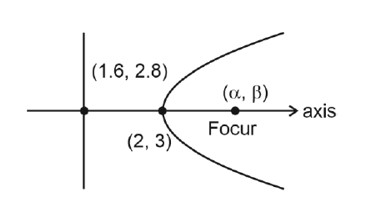Consider a hyperbola H: x² - 2y² = 4. Let the tangent at a point P(4, √6) meet the x-axis at Q and latus rectum at R(x₁, y₁), x₁ > 0. If F is a focus of H which is nearer to the point P, then the area of ∆QFR is equal to :
Consider a hyperbola H: x² - 2y² = 4. Let the tangent at a point P(4, √6) meet the x-axis at Q and latus rectum at R(x₁, y₁), x₁ > 0. If F is a focus of H which is nearer to the point P, then the area of ∆QFR is equal to :
Option 1 -
4√6 - 1
Option 2 -
4√6
Option 3 -
√6 - 1
Option 4 -
(7/√6) - 2
-
1 Answer
-
Correct Option - 4
Detailed Solution:The equation is for a hyperbola: x²/4 - y²/2 = 1.
The eccentricity e is given by e = √ (1 + b²/a²) = √ (1 + 2/4) = √6/2.
The focus F is at (ae, 0), which is (2 * √6/2, 0) = (√6, 0).
The equation of the tangent at a point P (x? , y? ) is xx? /a² - yy? /b² = 1.
The equation of the tangent at P is given as x - (√6 y)/2 = 1.
This tangent cuts the x-axis (y=0) at x=1, so Q is (1, 0).
The latus rectum is the line x = ae = √6.
To find the point R where the tangent intersects the latus rectum, we substitute x=√6 into the tangent equation:
√6 - (√6 y)/2 = 1 &r...more
Similar Questions for you
ae = 2b
Or 4 (1 – e2) = e2
4 = 5e2 ->
If two circles intersect at two distinct points
->|r1 – r2| < C1C2 < r1 + r2
| r – 2| < < r + 2
|r – 2| < 5 and r + 2 > 5
–5 < r 2 < 5 r > 3 … (2)
–3 < r < 7 (1)
From (1) and (2)
3 < r < 7
x2 – y2 cosec2q = 5
x2 cosec2q + y2 = 5
and
->
1 + sin2q = 7 – 7 sin2q
->8sin2q = 6
->
->

Slope of axis =
⇒ 2y – 6 = x – 2
⇒ 2y – x – 4 = 0
2x + y – 6 = 0
4x + 2y – 12 = 0
α + 1.6 = 4 ⇒ α = 2.4
β + 2.8 = 6 ⇒ β = 3.2
Ellipse passes through (2.4, 3.2)
⇒
&
Taking an Exam? Selecting a College?
Get authentic answers from experts, students and alumni that you won't find anywhere else
Sign Up on ShikshaOn Shiksha, get access to
- 65k Colleges
- 1.2k Exams
- 679k Reviews
- 1800k Answers
